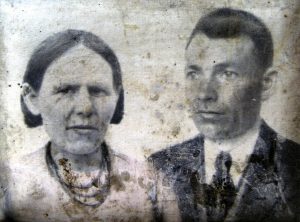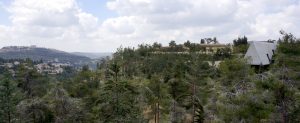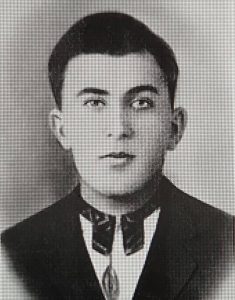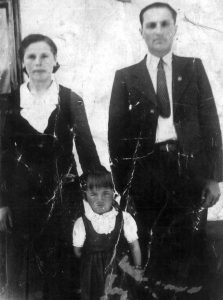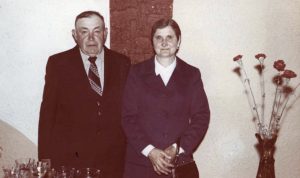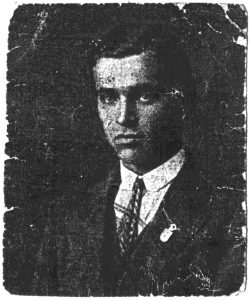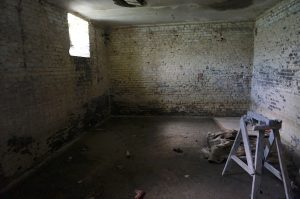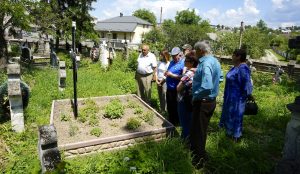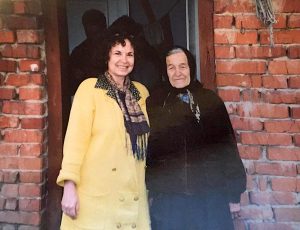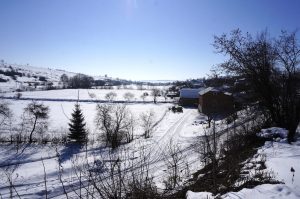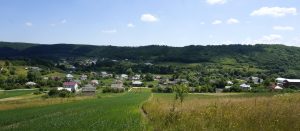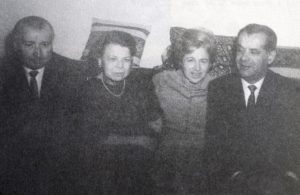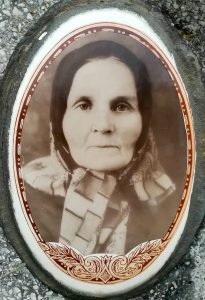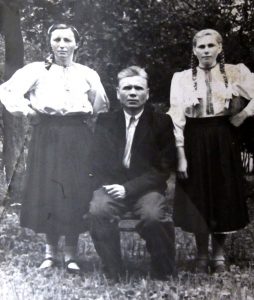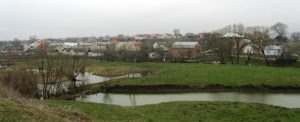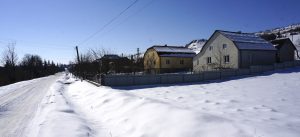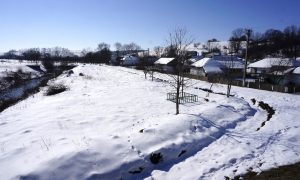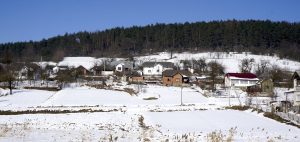![]() Ця сторінка також доступна українською.
Ця сторінка також доступна українською.
Introduction: The Importance of Names
In Ashkenazic Jewish tradition, personal names are powerful tools for remembrance and honor. Alexander Beider’s article on “Names and Naming” in the YIVO Encyclopedia of Jews in Eastern Europe notes that “[t]he custom of calling children after deceased relatives existed in German lands by the Middle Ages and was reinforced over the centuries”. This custom spread throughout eastern Europe with the settlements of Jews; it dominates pre-war Jewish birth records in Rohatyn and continues in many Rohatyn descendants’ families today.
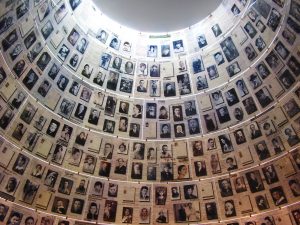
The Hall of Names at Yad Vashem. Source: Wikimedia Commons.
Israel’s official state memorial to the victims of the Holocaust, Yad Vashem, emphasizes the importance of names in its very title (shem means name in Hebrew). The center maintains a central database of Shoah victims’ names, and each year leads a public ceremony in Jerusalem called “Unto Every Person There Is A Name” on Holocaust Remembrance Day. During the ceremony, the names of individuals who perished in the Shoah are read aloud, one at a time, as an act of ritual memory. Similar ceremonies are also held in Jewish communities around the world, in public places and in private homes.
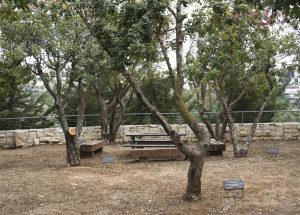
The Avenue of the Righteous at Yad Vashem. Photo © 2014 RJH.
It is fitting that the same focus on names is also applied to commemorating and honoring those gentiles (non-Jews) who risked their own safety in attempting to aid or rescue Jews during the German occupation of Europe in World War II. Yad Vashem calls these people Khassidei Umot HaOlam, the Righteous Among the Nations. Research on the saviors of Jews was one of the founding responsibilities of Yad Vashem and was included in the law which established the memorial center in 1953, although for the first decade of its operations, as was true also in the writing of individual Jewish survivors, the primary focus was on study of the destruction of Europe’s Jewry and on the victims.
It is significant, and essential, that the names of honorable gentiles come from the direct testimony of Jews who were rescued; no one can disregard the importance of these sources. For more than 50 years, Yad Vashem has been documenting the names of individuals who meet its criteria for recognition as Righteous Among the Nations; the list now totals more than twenty-five thousand people (groups and organizations are not eligible by Yad Vashem’s criteria). As of 01 January 2018, 2619 individuals have been recognized in Ukraine. Of those, 23 were from the Rohatyn area (see below); between them they saved more than 38 Jews who had escaped the murderous aktions of Rohatyn, Bukachivtsi, Burshtyn, and Berezhany; two of these righteous individuals were executed during the war for their actions to save Jews. We cannot know how many others aided Jews who ultimately did not survive the war; no one can tell their story.
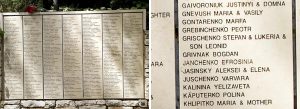
A Wall of Honor at Yad Vashem. Here, wall 28 honors a portion of the Ukrainian Righteous, including Bohdan Hryvnak of Chesnyky.
The memoirs of Rohatyn ghetto dwellers clearly depict the long odds of survival, even with external aid; only a tiny fraction of the Jews from the region lived through repeated round-ups for killing or deportation, hiding in forests and barns for a year or more, and the constant military and paramilitary hunts for survivors. Further, the memoirs illustrate how saving a single Jewish life typically required the assistance of multiple “others” over the duration of the occupation; Jack Glotzer describes nine instances of life-saving aid from gentiles during his nearly thirteen months in the woods around Rohatyn [3]. In eastern Galicia, in the city of Lviv some limited organized resistance to the Nazi persecution of Jews has been documented for local church leaders and for Jewish aid groups such as Żegota, an arm of the wartime Polish Underground State, but these organizations had no significant influence in Rohatyn or in smaller surrounding towns and villages where Jews hid. Rescuers nearly always worked alone, even if in close proximity (see for example the clandestine contact in hiding between Jack Glotzer and the Wohl family, each aided by separate gentiles working in the same forests east of Rohatyn).
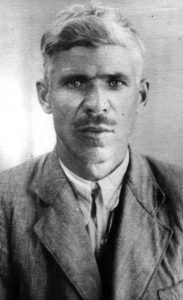
Fyodor Penderetskiy, who with his wife and son rescued more than 17 Jews in the forest near Bukachivtsi. Source: Yad Vashem.
A few of the recognized Righteous in eastern Galicia were individuals in influential positions, such as Klymentiy Sheptytsky, Studite Brethren archimandrite of the Ukrainian Greek Catholic Church in Univ and brother of the Metropolitan Archbishop Andrey Sheptytsky (who also aided many Jews but has not been formally recognized by Yad Vashem). Some of those recognized worked with less formal influence, such as the Greek Catholic priest Marko Stek, who aided Klymentiy Sheptytsky in sheltering and moving Jewish men, women, and children in monasteries around western Ukraine [13, p.54-103]; Stek was born and educated in Stratyn, a village 10km from Rohatyn and famous among Rohatyn Jews as the origin of several of the city’s most admired rabbis. The vast majority of those recognized, however, were ordinary people, many very poor themselves, who responded instinctively when a Jew in distress knocked at their door or window; the background stories of the recognized Righteous from the Rohatyn area illustrate this very clearly.
As Yad Vashem explains, not all of the individuals who aided Jews are recognized as Righteous Among the Nations. Yad Vashem’s criteria for awarding the title require, among other conditions, “[t]he existence of testimony of those who were helped or at least unequivocal documentation establishing the nature of the rescue and its circumstances”. Jews who were unable to survive the war or the early post-war years, even with the aid of others, could not submit testimony for consideration; their stories are lost forever, taking with them the identity of those who contributed to their initial survival. Some Jewish survivors who were aided did not, for a variety of reasons, make application to Yad Vashem on behalf of their helpers, even when they recorded that help in memoirs and interviews.
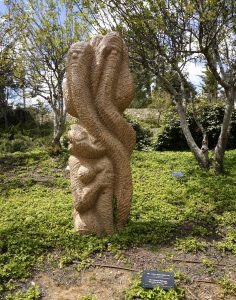
The Memorial of the Anonymous Rescuer at Yad Vashem. Photo © 2014 RJH.
Many gentiles who helped Jews did so without any public recognition simply because their names were never known to those they saved, or were forgotten during the decades after the war, when travel and communication in the Rohatyn area were limited by the Cold War. Several of the Jewish survivors of the Rohatyn area acknowledge these gaps in their later writings, and express sorrow at their inability to adequately thank those who helped them. We understand that the probability of ever identifying any of these good people by name is very slim, but we list the helping actions here with what details still remain in the hope that others may recognize something about the people or the places to add to these stories.
Other key Yad Vashem conditions for granting the Righteous title are “[r]isk to the rescuer’s life, liberty or position”, and the selfless motivation of the rescuer, “i.e. not for payment or any other reward”. Both of these conditions can be very difficult to evaluate long after the war and based on limited documentation, especially to establish the point at which self-sacrifice crosses a mortal threshold. In our own compilation of names for this project, we do not feel as qualified to judge as the Yad Vashem Commission which designates Righteous status; we prefer to list the known details here so that all can give consideration to these actions to save Jewish lives.
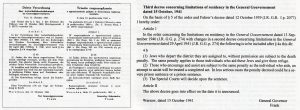
The German decree imposing the death penalty for anyone aiding Jews in the General Government. Source: Muzeum Historii Polski.
This issue is particularly important for actions in the eastern Galicia region, including Rohatyn. Under German occupation as part of the stateless General Government, an October 14, 1941 decree by Hans Frank imposed a death penalty on any individuals who gave Jews aid or refuge [12]. This decree remained in effect and prominently publicized in the region for the next three years of German occupation, justifying the execution of at least one man from the Rohatyn area who had helped his Jewish friend [1, rescue 4015122]. In the afterword to Martin Gilbert’s “The Righteous: The Unsung Heroes of the Holocaust”, he writes that “inaction motivated by fear cannot be belittled”. Many of the Jewish memoirs of wartime Rohatyn describe the very real fear expressed by potential rescuers, not only from the German occupiers but also from their neighbors and others who might denounce them for bounty or other reasons; for some rescuers, this fear lasted long after the war had ended. The wartime danger to everyone in the Rohatyn area makes the rare actions of the individuals named on this page more remarkable, and more deserving of remembrance.
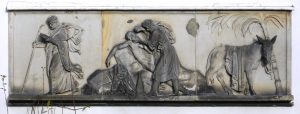
An 1833 sculpted relief of the Good Samaritan parable by Kümmel. Source: Wikimedia Commons.
As in any discussion about the actions of individuals during great conflicts, questions about the motivations of those who do good are somehow more difficult for many of us to answer than for those who do harm, or those who remain indifferent. In Christian teaching, the Parable of the Good Samaritan (in Luke 10:25-37) can be instructive on multiple levels, in answering the question “Who is my neighbor?”, in considering the meaning of “others”, and in the “ever ancient, ever new” social, ethical, and religious importance of mercy. Gilbert analyzes writings on the topic of motivations at length in “The Righteous”, and Mordechai Paldiel, Yad Vashem’s director of their Department of the Righteous for more than twenty years, also wrote a lengthy essay reflecting on those motivations. Answers to these questions are subject to local and regional differences, especially in historical events of the previous decades. Although we acknowledge the complexity of certain instances of rescue actions in the names sections below, we do not consider the topic further here, leaving the questions to research by others, using the general sources listed at the bottom of this page or other materials.
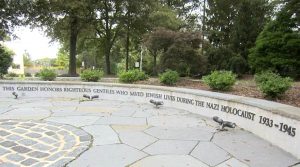
Entrance to the Wilmington Garden of the Righteous. Photo © 2015 Ryan Woodward for the
Halina Wind Preston Holocaust Education Committee of the Jewish Federation of Delaware.
Although it is the first and the largest, Yad Vashem is of course not the only institution which works to recognize righteous gentiles and to honor them with permanent public installations. Other individuals and organizations have followed the Yad Vashem example of planting trees or gardens in the spirit of Psalm 1:1-3: the Garden of Righteous Gentiles in Wilmington, Delaware was the first in the US, begun in 1981 and dedicated in 1983; the Garden of the Righteous of Warsaw was the first in Poland, inaugurated in 2014; other gardens have been established in Italy, Switzerland, and Tunisia. The theme has also expanded beyond the Holocaust to recognize heroism in the face of other crimes against humanity, for example in the 2012 declaration of the European Parliament establishing an annual European Day of the Righteous.
Facing the dark period of the years of German occupation in Rohatyn, it is interesting to note that among the more than one thousand pages of Jewish Rohatyn memoirs and histories, including hundreds of pages specifically covering events of the occupation, apart from a few of the German commanders at the top of regional administrations, almost none of the perpetrators of the Holocaust in Rohatyn and the surrounding area are named. In this case, not naming is as powerful as naming, for shaping memory.
Jewish writing has commemorated non-Jews who saved Jewish lives for at least two and a half millennia: the Book of Exodus [1:15-22 and 2:1-10] tells how Pharaoh’s daughter found the infant Moses (future prophet to the Israelites) hidden in reeds on the Nile river, and protected the child against the command of her father to kill all male Hebrew children, then raised the boy as her own; she was exiled by Pharaoh for opposing his command. In Exodus, Pharaoh’s daughter is not named, but later Jewish scholars gave her the name Bithiah (or Batya), “daughter of God”, to honor her act. It is with respect and humility that we name here the known righteous people who aided and saved Jews in the Rohatyn area, as well as those whose efforts were recorded but whose names are not yet known and may never be known, to commemorate their acts and their lives as part of the history of the Jewish community of Rohatyn. These rescuers are grouped here in three categories:
- Recognized Righteous Gentiles
- Named Righteous Gentiles
- Unnamed Righteous Gentiles
This compilation is a work in progress, and we welcome contributions to the lists.
A brief bibliography of more than a dozen footnoted and general sources is included at the bottom of this page.
Recognized Righteous Gentiles of Rohatyn and Surrounding Villages
The list below includes all individuals recognized by Yad Vashem as Righteous Among the Nations for their actions rescuing Jews in the Rohatyn region. Each of these individuals is inscribed on Yad Vashem’s Walls of Honor on the Mount of Remembrance in Jerusalem. For each individual or family name below, a brief summary of the rescue action is included, with a link to the Yad Vashem rescue story and other sources for further details.
Bohdan Hryvnak (Chesnyky)
references: [1, rescue 4015122] [9, multiple pages] [11, VHA#31757 and VHA#44311]
Bohdan Hryvnak gave his baptism certificate and other identity papers to Boris Arsen, a Jewish friend and fellow pedagogical student in Stanisławów who was interned in the Rohatyn ghetto with his family. With his father and other family members, Hryvnak supported the false identity so that Arsen could visit his family in the ghetto. After the liquidation of the Rohatyn ghetto, the Hryvnak home was searched, and following suspicion over the double use of Hryvnak’s identity, Hryvnak was killed by Germans in December 1943.
Piotr Kmieć, his wife Anna, and their daughters Stefania and Franciszka (Kuropatnyky, near Burshtyn)
reference: [1, rescue 4034921]
The Kmieć family (Piotr, his wife Anna, and their daughters Stefania and Franciszka) sheltered eight Jews, former neighbors including the Katz and Fogelman families, who had escaped an aktion in Berezhany. The Kmieć family gave them space in their house and aided them in hiding in the forests, providing them with food and health care. In April 1944, Piotr was killed by Ukrainian nationalists, but Anna and the girls continued to care for the Jewish refugees until the Soviet army drove the Germans out a few months later.
Stanisław and Franciszka Pizio, and Maria and Władysław Dżugała (Pidkamin)
references: [1, rescue 4039660] [2, p.320-335]
Maria Dżugala and her husband Władysław sheltered Regina (Rivka) Hader, a former school friend of Maria’s in Pidkamin, after Hader’s escape from the Rohatyn ghetto during the December 1942 aktion. When conditions in the Dżugala’s single-room apartment became risky, Hader was transferred to the farm of Maria’s parents, Stanisław and Franciszka Pizio, where she remained safe until the region was liberated in 1944.
Mykhailo and Lubomira Belegai (Zhuriv)
reference: [1, rescue 4442565]
Mikhailo and Lubomira Belegai, parents of a young daughter and living on a farm in Zhuriv, sheltered three former neighbors, Eliezer Schreier and his young sons, who had survived aktions in the Bukachivtsi and Rohatyn ghettos. For over a year, until the region was liberated, the Belegais provided food and shelter in their barn and other hiding places as needed to avoid detection by Germans and others.
Fyodor Penderetskiy, his wife Anna, and their son Nikolay (Tenetnyky, near Bukachivtsi)
reference: [1, rescue 4039954]
The forester Fyodor Penderetskiy became aware in late 1942 that Jews were hiding in the forests he managed near Bukachivtsi, and determined to supply them with food and clothing. For the next year and a half, until liberation, Penderetskiy with his wife Anna and teenage son Nikolay aided more than 17 Jews to find shelter and care in the forest, moving refugees as needed to avoid capture, and providing them with essential supplies. Family names of the saved included Nagelberg, Shumer, Feldman, Drach, Kosten, Dikman, Erenberg, Shiffer, Bien, Shenkler, and others.
Kazimierz and Maria Bodaszewski, with Antoni Malinowski (Honorativka, near Chesnyky)
reference: [1, rescue 4034417] [2, p.529] [3, p.26, 28, 513-514]
In 1943, Kazimierz and Maria Bodaszewski sheltered three members of the Wohl family who had recently escaped from the Rohatyn ghetto, first in their home and then in forests nearby, providing them with food, clothing, and medicines in their hiding places. In the forests, the Wohls were also aided by Antoni Malinowski, who dug a shelter for them, provided food and other essentials, and warned them of dangers, until liberation came a year later.
Jan Kuchta, his wife Józefa, and their children Jan, Aniela and Władysława (Lukovets, between Zhuravno and Zhuriv)
reference: [1, rescue 4044913]
Jan and Józefa Kuchta, with their children Jan, Aniela and Władysława, gave shelter, food, and care to David Liberman of Zhuravno and his wife and son, at their farm home in a village on the road to Zhuriv. When raids and patrols made hiding at their house especially dangerous, the Kuchtas led the Libermans at night to a safer place in the nearby forest, helping them to create a shelter and providing them with food and clothing until they could return to the farm. The Kuchtas looked after the Libermans, and later also Moshe Princ, for over a year until the liberation in 1944.
Kyrylo Kindrat (Sloboda, near Burshtyn)
reference: [1, rescue 4015624]
Beginning in 1943, Kyrylo Kindrat sheltered his former professor from Lviv, Isaac Shlezinger, in his barn and in a dugout in his garden, and then because of the relative isolation of his farm, in his home. The two men shared Kindrat’s home for a year until liberation, then both became teachers in Burshtyn.
Named Righteous Gentiles of Rohatyn and Surrounding Villages
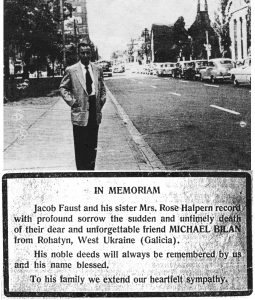
A photo of Michael Bilan (see below) from 1956, and a memorial to him after his passing. Source: Rosette Faust Halpern collection.
The list in this section includes the partial or complete names of individuals who provided aid to Jews in the Rohatyn area during the German occupation, in the ghettos or elsewhere after the ghettos were liquidated in final aktions. For one reason or another, these gentiles have not been officially recognized as Righteous Among the Nations by Yad Vashem. We suppose that in most cases, no application to Yad Vashem has been filed and processed. For some of these individuals, there is not yet sufficient information available to clearly identify them in an application, and now that nearly all of the Jewish survivors have passed away, it may never be possible to identify many of the rescuers. Most of the information here comes from the Rohatyn Yizkor book and from several memoirs of Jewish survivors of the Rohatyn ghetto, footnoted at the end of this page. The spellings of personal names listed here are taken from the memoirs; often these spellings reflect the Yiddish or Polish mother tongue of the memoir writer, regardless of the nationality of the righteous individual.
This list represents the current status of ongoing research by Rohatyn Jewish Heritage, which for reasons described in the Introduction will always be incomplete. We welcome any input and resources which may help to expand this list of names, or to provide further information about the righteous, their families, and their actions in or near Rohatyn during the occupation. Please use our contact page to correspond with us on this topic.
(Unknown) Babink (Rohatyn)
reference: [6, p.11, 37, 47, 59-60]
Babink was an attorney in Rohatyn, and a friend of the Weiler family; he and his family helped the Weilers with food and supplies during their time in the Rohatyn ghetto, despite the German decree of death to anyone aiding Jews. Babink also entered the ghetto in late 1942 to warn the Weilers that the ghetto was about to be enclosed with barbed wire, and he then arranged for transport of a suitcase for Sheva Weiler (later Sylvia Lederman) when she secretly left the ghetto forever. The fate of the Babinks after the war is unknown.
Anna Baczynska and her daughters Lidia (Lida) and Marta (Tunia, Tanya) (Rohatyn)
references: [4, p.vii, 95-97, 101-102, 105-106, 109-112, 114-115, 117-119, 121] [7, 08:40-09:47, 10:59-11:49]

Rosette Halpern with Mrs. Baczynska and her daughters, after the war; the Baczynski house in Rohatyn. Source: Rosette Faust Halpern collection.
Through family connections in Rohatyn before the German occupation, the young Jewish women Roza Faust (later Rosette Faust Halpern) and Klara Weisbraun (later Schnytzer) were sheltered in secret in the home of Anna Baczynska (née Kosmyna, originally from Cherche), outside the ghetto. When she was a child, Anna had been a music student of Roza’s father. The two Jewish women slept in a bedroom together with Anna’s daughters Lidia and Marta, and were fed and protected by the Baczynskis. This arrangement began before the Rohatyn ghetto liquidation in June 1943, and lasted for about ten months until late winter or early spring 1944, when the approach of the Red Army threatened the Baczynski family. Before the Baczynskis left Rohatyn for Germany, they helped to arrange new shelter for both Faust and Weisbraun, and transported the Jewish women to their next rescuers. Under the German occupation, the Baczynski family home was relatively secure despite the German decree of capital punishment against aiding Jews, but Schnytzer said of Anna Baczynska, “she risked her life, I must admit, because if they had found us there, the whole family would have been murdered” [7, 11:40]. Anna Baczynska and her daughters visited Halpern in the US sometime after the war, but otherwise their whereabouts post-war are unknown.
This rescue story is complicated by the fact that the head of the Baczynski family, Anna’s husband, was the commissar of the Ukrainian Auxiliary Police in Rohatyn, generally an adversarial force to the Jewish community while it was interned in the ghetto. However, it seems unlikely at best that Baczynski was unaware that his wife and daughters were sheltering Jews in their home for nearly a year.
Michael Bilan (Rohatyn)
reference: [4, p.vii, 124-128]
After the Baczynski family left Rohatyn, Roza Faust (later Rosette Faust Halpern) was briefly housed and fed by her former gymnasium teacher Mrs. Savitska and an elderly woman known only as Kasia, who then also helped her find shelter with Michael Bilan, the former manager of the Rohatyn electrical power plant. Bilan was already under suspicion by the Germans for sheltering his Jewish girlfriend, Helen Landau, and her sister; Bilan moved the Landau sisters to a nearby village to evade discovery in Rohatyn, but they were betrayed and killed there. Bilan gave Faust food and made a shelter for her in the basement of his building; a friend of Faust’s, Katriusia Mosora, also brought food and clothing. German officers moved into Bilan’s building the next day; Faust remained in Bilan’s attic apartment on and off for the next days until the German army retreated west ahead of the Soviet advance. Bilan was taken and forced to work as an electrician in a labor camp in Vienna as part of the Nazi slave labor Ostarbeiter program, until the war ended. Probably he spent time in a displaced persons camp, and then emigrated to the United States. His brother placed a death notice in the Ukrainian daily newspaper Svoboda that he had passed away in New York in December 1954 at the age of 48. He had stayed in contact with Rosette and the Faust family after the war; in a memorial announcement they wrote at his passing, Rosette and her brother Jacob said, “His noble deeds will always be remembered by us and his name blessed.”
Oksana Bilej (Skomorokhy, about 25km southeast of Rohatyn)
reference: [4, p.vii, 110-116]
Following aktions in the Rohatyn ghetto in late 1942, two gentile women, Anna Baczynska (see above) and the gymnasium teacher Mrs. Savitzka, who had been sheltering Roza Faust (later Rosette Faust Halpern) at their homes, began to look for safer accommodations for her. Using the false identity of the recently deceased Darka Wasilkiewitz, Faust was transferred to the care of Oksana Bilej, who employed Faust to care for her aged mother in the village of Skomorokhy near Burshtyn; Bilej was aware that Faust was Jewish, but Bilej’s mother was not. During the three months that Faust remained in Skomorokhy, Bilej helped to mask the Jewish identity of Faust, including teaching Faust the core Christian customs so she could appear to fit in, despite the curiosity of locals as well as inquiries from a local priest and the Gestapo administration. Bilej’s fate after the war is unknown.
Panteleimon Brodoviy (Rohatyn)
references: [2, p.338-339] [3, p.31] [RJH news 21Jun2017]
Yehoshua Spiegel, a member of the Rohatyn Yizkor book’s organizing committee, wrote a brief chapter for the “Lamentation” section of the Yizkor book, about a remarkable story of wartime Jewish salvation within the walls of a Rohatyn building which housed the Gestapo command center. In just over a page, Spiegel related that a Ukrainian man from Putiatyntsi who he named Brudovay, and who worked as a watchman at the building, had hidden thirteen Jews in the cellar (where council archives were kept), literally under the feet of the Gestapo, shielding the Jews from the Germans and providing food when possible. When the Gestapo needed more space in the building and intended to use the cellar, the watchman convinced them that the archives should be preserved and the Gestapo should look elsewhere. Based on information from some of the saved, Spiegel reported that the Jews who were protected included Yehoshua Glotzer with his daughters Lusia and Rozia; Avraham Haber with his wife Libtsie and son Yisrael; Reize Stryer with her son Yosi; the siblings Rachel and Moshe-Yosef Bal; their cousin Bernard Kessler; Sarah Rokeach; and Chanina Sonnenschein. Starvation took the life of Avraham Haber, then drove Sonnenschein, Moshe-Yosef Bal, and Yosi Stryjer to risk scavenging food outside the cellar; all were caught and killed. The other nine Jews survived to the end of German occupation, although in poor health. About the man who sheltered the cellar occupants, Spiegel wrote, “This gentile should be well remembered. The glimmer of G-d had not been extinguished in his heart, one of the few among many…”
In 2016 and 2017, the daughter of Sarah Rokeach, Batya Kidron, who had only learned of her mother’s wartime ordeal after Sarah passed away, contacted the city of Rohatyn with the hope of identifying the man who had aided her mother. Through the research of Mykhailo Vorobets, a local historian and retired teacher who had heard the story from a co-worker in Rohatyn many years earlier, the rescuer was identified as Panteleimon (Panko) Brodoviy, born in 1884 in Babukhiv, a village near both Putiatyntsi and Rohatyn. The Vorobets and Brodoviy families are related; an Andrey Vorobets was recorded as witness to Panko Brodoviy’s wedding in 1908 to his wife Anna. Additional family details and information about the work at the administration building, based on research by Vorobets and others in Rohatyn, were provided in an emotional meeting between Kidron, her husband, two Israeli friends of theirs, Vorobets, Rohatyn city staff, and Ivan Brodoviy, nephew of the wartime rescuer, held at the Rohatyn public library in summer 2017. Panko Brodoviy remained in the Rohatyn area after WWII, and died in 1954; his wife Anna had died the previous year. They are buried together in the cemetery adjacent to the Holy Spirit Church in Rohatyn.
This summary is complicated by a passage in the memoir of Kuba Glotzer. When Kuba returned to Rohatyn after more than a year in hiding in the forests east of town, he met his uncle Shiye Glotzer and Shiye’s daughters Lusia and Rózia, and others who had been in the basement of the government building. Kuba learned from some of the others that in addition to providing food to the Jews, “the janitor” had sexually abused the hidden women, threatening to take them upstairs to the Germans if the women did not perform for him. We have no corroborating testimonies from other survivors in the basement group about this version of the story.
Hanka Buczek (Ruda)
reference: [6, p.55-57] [2, p.315]
Hanka Buczek was an older Polish woman originally from Rohatyn who worked as a housekeeper for a priest in the nearby village of Ruda during the German occupation. When Buczek encountered a Jewish acquaintance, Sheva Weiler (later Sylvia Lederman) following the second aktion in the Rohatyn ghetto, and understood Weiler’s predicament, Buczek offered Weiler her birth certificate to serve as a false identity. Weiler used Buczek’s Polish identity as her own and to obtain passage out of the wartime General Government and into Germany as a forced-labor worker, where she survived to the end of the war. Lederman wrote in her memoir about Buczek handing her the birth certificate, “If her complicity in the transaction were disclosed, she would pay for it with her life.” The post-war fate of the real Buczek is not known.
Paranka Burachok (Cherche)
references: [14] [11, VHA#15986] [4, p.117]
In late 1942, Berta (née Faust) and Yosef Blitz had a five-year-old son (Abraham, called “Boomche” and later Avi), and a daughter (Cipora) only one and a half years old living with them in the Jewish ghetto in Rohatyn. During the German-led roundup of Jews in the ghetto on December 8 of that year, Cipora was discovered hidden in a laundry basket, and the Germans put her on a truck for deportation with other children and adults; their destination was the Bełżec extermination camp. Miraculously, someone pushed the child out of the truck into the snow before the truck departed from Rohatyn; the young girl was later found and returned to her family alive.
Hoping to protect her young niece from further danger, Berta’s sister Roza arranged to place Cipora with a friendly Ukrainian woman in the nearby spa town of Cherche. The woman, Paranka Burachok (née Paraskoviya Kosmyna), was very fond of Cipora’s grandfather David Faust, who had been the leader of Rohatyn’s famous Faust family klezmer orchestra. David had also taught music to Paranka’s sister Anna (later Baczynska, recorded above) and Anna’s son Yarema, and David was well liked in the Christian community because he and his orchestra skillfully performed Polish and Ukrainian melodies for free during Christian holidays. Paranka Burachok lived in a one-room house in Cherche with her teen-aged sons; her husband had left her some years earlier. Paranka sheltered and fed Cipora for two weeks in her home. Cipora was blonde and without distinctly Jewish features, but Paranka’s neighbors suspected the girl was Jewish and threatened them both. Paranka was unconcerned for her own safety, but out of anxiety for the girl’s life, after two weeks she took Cipora back to her parents in the ghetto. Cipora, her brother, and their parents survived subsequent aktions, and later fled from the Rohatyn ghetto to the forests near their former home in Bukachivtsi, where they remained until liberation. Cipora learned about Paranka’s selfless actions from her parents when she was a young girl; Cipora has written, “My mother often told us about this wonderful Ukrainian woman.” When the Soviets re-occupied Rohatyn in 1944, they arrested one of Paranka’s sons on a charge of collaboration with the Germans; Cipora’s mother Berta Blitz testified on his behalf with the story of Paranka sheltering her daughter, and the son was released from prison.
After Ukraine gained independence, Cipora Blitz traveled to the Rohatyn area in 1994, and then again in 1998 with her sisters and other descendants and survivors. Both times she met with Paranka Burachok at her home in Cherche, and with several of Paranka’s family members. On a return trip in 2007, Cipora learned that Paranka had passed away at age 95.
In 1996, Cipora Blitz gave video-taped testimony to the USC Shoah Foundation about her wartime experiences as told to her by her parents, and about her post-war life in Poland and beyond from her own childhood memories. When asked in the interview about her motivations for making the testimony, Cipora said she wanted to acknowledge the Christians who had helped her and other Jewish survivors during the war.

Paranka Burachok at her house in 1994 with Cipora and the family of one of Paranka’s sons, and in 1998 with Cipora and her sisters. Source: Cipora Blitz.
(Unknown) Dubski (Verkhnia Lypytsia)
reference: [3, p.22-23]
When Kuba Glotzer and his cousin Josie Altman were refugees after the Rohatyn ghetto liquidation in June 1943, and were directed by a rescuer to the barn of Mr. Dubski in Verkhnia Lypytsia (Lipica Górna in Polish), the local Jewish family of Suchar Hauser and his children Dzunia and Lonek were already hiding there. It turned out that Kuba and Josie were traveling with Mr. Hauser’s nephew. Mr. Dubski sheltered and fed the six refugees, despite his fears about the strong presence of German soldiers prowling the village looking for hidden Jews. Hauser told Glotzer that Dubski was a Jehovah’s Witness (or perhaps an Adventist), part of a pacifist religious faith. The six Jews stayed in the barn for two weeks, with food and shelter from Dubski’s family, as their fears mounted. When Glotzer heard that there were other Jews from the Rohatyn ghetto in the woods nearby, he and his cousin with Hauser’s nephew decided to relieve the Dubskis of part of their burden, and they left for the forest despite the German patrols; the Hausers stayed behind with the Dubskis. The later fate of the Dubskis and the Hausers is not known; both Hauser’s nephew and Josie Altman were later shot and killed in the forests. Glotzer wrote of the Dubskis and another woman of the same faith, “I feel, even today, that I owe my life to these kind people. They made my survival possible in my darkest hours.”
(Unknown) Jagoda or Tadeusz Czewochowski (Lviv)
reference: [6, p.125-150, 162-163, 167, 201-202] [2, p.317]
Before the war, Dr. Jagoda had been a veterinarian from Kalisz, Poland; he was an air force pilot at the start of the war, and was wounded in the leg. When he met Sheva Weiler (later Sylvia Lederman) in June 1943, he was working as a doctor, processing young men and women through registration and medical exams at the Janowska work camp in Lviv. Recognizing that Sheva was Jewish, though she was carrying false Polish identity papers, he gave Sheva medicines to fake an illness and worked to find a way for her to get out of the camp undetected. Dr. Jagoda also gave Sheva an exit pass, and arranged for her to stay in a storage building at the edge of the camp, where he brought her food and removed her waste almost daily. After a week in the shelter, Dr. Jagoda helped Sheva return to the camp and register as a volunteer for work in Germany, and protected her true identity through the remaining processing and transfer. Dr. Jagoda’s fate after the war is unknown. Named as Dr. Jagoda in Lederman’s memoir, in the Rohatyn Yizkor book the doctor is named as Tadeusz Czewochowski.
(Unknown) Koeniksberg, his wife, and their daughters Janina, Urzhula and Cesia (Lopushnia)
reference: [5, “In Hiding”]
The Koeniksbergs were the wealthiest family in the village of Lopushnia east of Rohatyn; Mr. Koeniksberg was Polish, and owned an oil press which processed seeds into oil for Lopushnia and the surrounding area. Koeniksberg served as a liaison between the Kimels (Leon and his son Alexander and daughter Luba) and their rescuer Matusiak (see below). When the shelter in Matusiak’s khotir became too dangerous in the summer of 1943, the Kimels were transferred to the Koeniksberg house, which was on the main road near the center of Lopushnia. Luba stayed in the main house and helped Mrs. Koeniksberg with chores and with lessons for the Koeniksberg’s three daughters Janina, Urszula and Cesia; Alexander and Leon stayed in a hiding place fashioned from straw in the barn. One of the Koeniksberg daughters, usually Cesia, brought Alexander and Leon food each day, pretending to feed the chickens in the yard to avoid suspicion. Once per week, Koeniksberg passed newspapers and other information to the Kimels, mostly about the progress of the war. The Koeniksberg property was very active each day with business associated with the oil press; Alexander Kimel speculated later that the high level of activity helped Koeniksberg avoid suspicion as a rescuer of Jews.
When autumn 1943 brought cold weather, Koeniksberg arranged for an underground bunker to be dug on his property in Lopushnia. He hired a Ukrainian man, Stepan (see below) to dig the bunker, cover it, and help the Kimels to furnish it. Koeniksberg continued to arrange for food and supplies for the Kimel men, and sheltered Luba in his house as a domestic servant. In spring 1944, the Red Army advanced near to Lopushnia, while reinforced German units scoured the forests to kill surviving Jews. Koeniksberg feared the advance of the Soviets (he had been labeled a kulak during the Soviet occupation four years earlier), and decided to move westward through Poland with the Germans; he left Stepan and enough food and supplies for two weeks, by which time he expected the Red Army to arrive. Luba joined Leon and Alexander in the bunker. The same day Koeniksberg left, German military police took over his house and then Germans were everywhere on the farm.
In all, Koeniksberg and his family sheltered and fed the Kimels for approximately eight months. The Koeniksbergs’ post-war fate is unknown.
(Unknown) Kowalski (Rohatyn)
reference: [6, p.54-55, 59, 62, 118]
Kowalski was the son of a Polish treasury official in Lviv who frequently traveled in the Rohatyn area. In autumn 1942, he became friends with Jews in Rohatyn and worked in secret to obtain false identity papers and travel documents for several Jewish internees of the ghetto there, including Sheva Weiler (later Sylvia Lederman), Simon Srebrnik, Hugo Goldberg, and others. Lederman reported in her memoir that Kowalski was “taken by the Gestapo” in Lviv sometime in early 1943; his ultimate fate is not known.
Yarema Krupka and his wife (Rohatyn)
reference: [6, p.11, 18, 22, 37, 47, 49, 55, 59, 66-103, 106, 116, 122-123, 209-210, 237-239] [2, p.314-318]
Yarema Krupka was a Ukrainian cooperatives administrator in Rohatyn and later a provisions officer for the Germans in Brody; he and his wife were parents of a small boy during the war. The Krupkas were friendly with the Weilers before the occupation, and aided them with food and supplies while the Weilers were in the Rohatyn ghetto. When Mr. Krupka took a job transfer and moved his family to Brody in November 1942, the Krupkas took young Sheva Weiler (later Sylvia Lederman) with them; Weiler had a Polish false identity. The Krupkas sheltered Weiler in their Brody apartment for six months, caring for Weiler when she had serious illnesses, and arranged city registration and work records for her to support her false identity. Mr. Krupka’s sister Olga, still living in Rohatyn, brought news of the ghetto there to Weiler in Brody. The Krupkas hid Weiler and protected her identity, even when they celebrated a Christmas dinner at their home with German and Ukrainian policemen. Mr. Krupka’s brother Franko, although an ardent supporter of the Germans and an officer, aided Yarema Krupka and his wife in concealing Weiler at their home. After a series of aktions in the Brody ghetto in April 1943, in May Weiler decided it had become too dangerous for herself and the Krupkas for her to stay at their home; the Krupkas then arranged for Weiler to go with false papers to Lviv and stay with Mrs. Krupka’s sister and her husband, the Tarashkewitzes (see below). In February 1944, the Krupkas moved from Brody to Vienna, and then to Munich, where they met Weiler in the summer of 1945. It is not known what became of the Krupkas after that; Lederman’s memoir includes a post-war photo of the Krupkas and Ledermans together at the Lederman home in the US, and there is a suggestion in the memoir that the Krupkas may also have had a home in the US at some point.
Hanna Kvasnevska (Rohatyn)
reference: [2, p. 539-540] [15]
Sabina Wind (later Fuchs/Fuks/Fox) fled the aktion of March 1942 with a young Jewish boy she did not know, a child of the Rohatyn shochtim, the Jewish ritual slaughterers for meat. Attempting to evade capture, they first hid in an outhouse not far from the town square, where most of the Jews from the ghetto were being gathered for execution. Forced from the outhouse, Wind and the boy turned into a courtyard behind houses ringing the square, and looked for shelter. A gentile in the courtyard told them to hide, then directed young Ukrainian men, who appeared in the courtyard searching for Jews, to look elsewhere. Another gentile, a woman, brought a dry sack to serve as a blanket and a tea kettle with hot coals to warm the young Jews, plus pieces of bread to feed them.
Sabina Wind Fuchs said later, “When such kindness is shown a Jew at a time when he is worth nothing – that is not something to forget.” On a visit to Rohatyn in the late 1990s with her husband Mordechai Fuchs and Fischel Kirschen, Sabina identified the woman who had helped her and the boy as Hanna Kvasnevska, born around 1900, who had worked as a kitchen maid for a local theological seminary and for Jewish families with small children; unable to bear how the Nazis humiliated Jews in town, Hanna fed and sheltered several Jewish children and adults at her home on Valova Street in Rohatyn for a period during the war. Hanna Kvasnevska died in 1975, and is buried in Rohatyn’s city cemetery. While visiting Rohatyn, Sabina met with Hanna’s daughter Maria Rykhlevych, bringing gifts and expressing gratitude for the life-saving actions of Hanna; this meeting is remembered with pride by Hanna’s descendants in Rohatyn. Sabina Wind Fuchs passed away in Israel in 2011.
(Unknown) Matusiak (near Rohatyn)
reference: [5, “The Rescue” and “In Hiding”]
A Polish man by the name of Matusiak sheltered Alexander Kimel and his father Leon in his home and barn in a small khutir (hamlet) near Rohatyn for two weeks in May 1943. A letter from Kimel’s sister Luba in the ghetto drew their father back there the day before the ghetto liquidation, but they were alerted just in time to hide in a bunker, escape the ghetto, and return to Matusiak’s residence. Matusiak kept the Kimels at his house and barn for a further period of one or two months, until his neighbors became suspicious and the Kimels had to leave. Nothing more is known about Matusiak.
Vasyl and Maria Popyk (Zalaniv)
references: [2, p.550] [10, witness YIU/2093U, 8:54-10:41, 21:47-23:50]
A Jewish girl about 8 years old was sent out of the Rohatyn ghetto by her mother at the time of a major aktion, perhaps the first mass killing in March 1942, and she returned later to find no one she knew still living. The girl, a daughter of Feivel and Amalia Reiss, lost her papers in the war and could not know the details of her birth date or other family info; she recalled her birth name as Zunca or Zuntsa. With no family and no idea what to do, she wandered from village to village around Rohatyn. In Zalaniv, there was a man she knew, and this man and his wife took her in to live with their son and their family, and raised her as their own child. The adopting couple were Vasyl and Maria Popyk. The girl took the name Mariya Vasylivna, was raised as Ukrainian in faith and customs, and later married a Ukrainian man named Tsapar and raised a family. She eventually moved back to Rohatyn, where she remained. Nothing more is known about the Popyk family.
Witold Runge (Rohatyn)
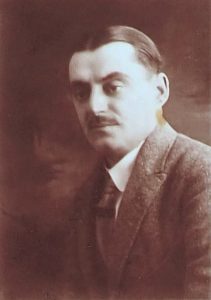
A portrait of Dr. Runge from the collection of Maciej Runge via Janusz Stanislaw Andrasz and Anna Brzyska.
reference: [2, p.448] [16] [17]
Dr. Abraham Sterzer reported in his essay for the Rohatyn Yizkor book, “How Rohatyn Died”, that during the German occupation “[t]he Jews had a friend in Rohatyn.” Dr. Runge was a Christian medical doctor who Sterzer says shared the suffering of the Jews in the ghetto and wanted to help them. A third-generation Polish patriot born in 1892, he had worked as a district doctor in Rohatyn before the war. During the occupation, the doctor frequently visited the ghetto to treat the sick and to comfort them. After the war, Dr. Runge left Rohatyn and settled in Brzesko, where he died in 1952. He is buried with his wife and mother in the old Catholic cemetery in Brzesko.
(Unknown) Sikorski (Babintsi)
reference: [3, p.21, 25]
In June 1943, immediately following the liquidation of the Rohatyn ghetto, a man by the name of Sikorski who had a house in the Babintsi suburb of Rohatyn provided shelter and food to Kuba Glotzer, his brother Samuel, and his cousins Clara and Josie Altman, in a hiding place he had prepared. The group remained there with a fifth Jew, Yankel Ouster, for five days until Sikorski’s wife became frightened of the German patrols around the house. Three of the group remained with the Sikorskis, while Kuba and Josie sought other shelter in the forest. Kuba’s brother Samuel and his cousin Clara stayed with the Sikorskis for at least two months, perhaps a year; they were betrayed and killed by the Germans two weeks before the liberation after moving to another shelter. The fate of the Sikorskis is not known.
(Unknown) Szostakowa (Bukachivtsi)
reference: [20, p.89-95, 102, 104-109, 132-133, 161, 169-170, 198]
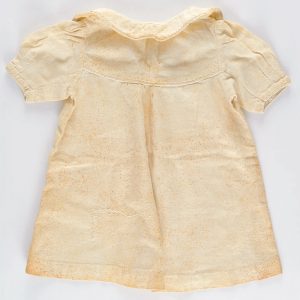
A white dress given by Szostakowa to Josef Kasten for his young daughter. Source: Yad Vashem Artifacts Collection.
Josef Kasten, a tailor, had befriended the widowed Polish farm woman Szostakowa before the war; she lived outside of Bukachivtsi on the road to the small village of Vytan with her two young daughters, and was very poor. Kasten bought farm goods from Szostakowa and did small favors for her, which endeared him to the poor woman. After the Kasten family escaped the Rohatyn ghetto and hid in the forest surrounding Vytan for more than two years, they struggled to feed themselves and frequently went without food. When they became desperate, Josef risked capture to go to Szostakowa’s house and beg for food. Despite the danger to herself and her daughters, and though she had little to eat herself, she always gave Josef something “for the children”. Once when a Jewish boy who had fled from other farmers near her home and hid in her shed, he was found by Germans with dogs and Ukrainian militia, and shot on the spot; they suspected Szostakowa of having hidden the boy, and interrogated her threateningly, but eventually let her go. Szostakowa always asked Kasten to leave quickly, but never empty-handed. Long after the war, Lina-Liba Kasten said to her daughter Dina who was a child in the forest: “To our sorrow, we had no way to repay her or her daughters after the war for the good she did us… We had nothing to give her except to show her our deepest gratitude. My children, never forget: it is thanks to this woman that our lives were saved from starvation several times. You must forever keep the memory of this dear woman.” The Kastens lost track of the widow Szostakowa after the war.
(Unknown) Tarashkewitz or Galitshuk (Lviv)
reference: [6, p.114-118, 120-124] [2, p.316-318]
Professor and Mrs. Tarashkewitz had a flat in Lviv where they fed and sheltered the young Rohatyn Jewish woman Sheva Weiler (later Sylvia Lederman) under an assumed name for almost two weeks. Mrs. Tarashkewitz was a sister of Mrs. Krupka (recorded above); the professor was retired. Weiler had been sent to the Tarashkewitz home by the Krupkas to escape the dangers of Brody and to help Weiler strengthen her false identity. The Tarashkewitzes were aware that Weiler was Jewish, and helped her conceal her true identity, even from their niece who lived with them. Nothing else is known about the post-war fate of the Tarashkewitzes. Named as Professor and Mrs. Tarashkewitz in Lederman’s memoir, in the Rohatyn Yizkor book the professor is named as Galitshuk.
Chana Warwanka (Bukachivtsi)
reference: [18] [19] [20]
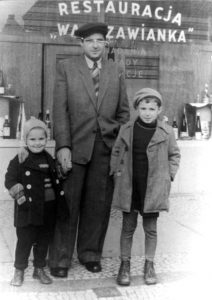
Cipora, Josef, and Avi Blitz in Poland about 1945. Source: Cipora Blitz via JewishGen.
Just before the Rohatyn ghetto was liquidated in June 1943, Josef Blitz with his wife and two children escaped the ghetto and traveled on foot over two nights to a dense forest surrounding the tiny village of Vytan near their native town of Bukachivtsi. There, they dug a deep pit bunker to shelter and hide in with two other families for 16 months. Finding food was very difficult; Josef and the other men had to leave the forest at night and scavenge in fields and barns in order to steal scraps and food for animals. When they became desperate, Josef appealed to a woman in Bukachivtsi, Chana Warwanka, who had worked for his parents before the war. According to the testimony of Josef’s son Avi, Warwanka remembered Josef and generously gave food for the family. Avi’s sister Cipora testified that her parents told her that Warwanka and other Christian villagers who knew Josef not only gave him food for his family and were kind to him, but three times encouraged him to keep going when he was despondent and wanted to give up. Josef, Avi, and Cipora all said they wanted to give testimony about their experience in order to acknowledge the kindly gentiles who gave them support until the German retreat. The postwar fate of Warwanka is not known.
Danylo (Unknown) (Rohatyn and Lopushnia)
reference: [5, “The Rescue”]
A Ukrainian man, named only as Danylo in the wartime memoir of Alexander Kimel, lived on a farm near the outskirts of Rohatyn. Danylo served the Kimel family (Alexander, his sister Luba, and his father Leon) in several ways from before the ghetto liquidation in June 1943 and for several months after. Danylo transported two or three of the Kimels at a time from the ghetto to a hiding place with the Pole Matusiak (see above) outside Rohatyn, carefully selecting routes when the roads were being searched by Germans, and he also sheltered the Kimels at his own home while they were in transit. Later Danylo transported the Kimels to another hiding place in Lopushnia. Nothing else is known about Danylo.
Stepan (Unknown) (Lopushnia)
reference: [5, “In Hiding” and “Liberation”]
In the village of Lopushnia, Alexander Kimel and his father Leon and sister Luba were sheltered and hidden on the farm of the Pole Koeniksberg (see above) from summer 1943 to spring 1944. In the autumn of 1943, Koeniksberg hired a Ukrainian man named in Kimel’s memoirs only as Stepan to dig an underground bunker for the Kimels to better protect them from the cold. Stepan knew the Kimels were Jewish, but continued to aid them and never betrayed their identity or hiding place, even when Koeniksberg fled west through Poland ahead of the advancing Soviet army, and when German military police occupied the Koeniksberg farm. Stepan was still on the Koeniksberg farm when Lopushnia was liberated, and brought the Kimels water when they finally emerged from the bunker. Nothing more is known about Stepan or his post-war fate.
Unnamed Righteous Gentiles of Rohatyn and Surrounding Villages
As noted in the Introduction, several of the Jewish memoirs of wartime Rohatyn describe righteous actions by local people who are not named in the texts; not enough information is available now about these individuals to determine who they were. Nonetheless, we have chosen to list them here with the source references and a brief summary in the hope that one or more of them may someday be clearly identified, as was possible through research in Rohatyn for one individual in 2017. At a minimum, we include the information here so that these individuals may be counted among those who opposed the larger trend among local gentiles of indifference and fear, and provided material support, shelter, and comfort to Jews in distress. As above, we welcome contact from anyone who can shed further light on these people.
Unnamed 01 (unknown village on the Hnyla Lypa river about 5km from Rohatyn)
reference: [7, 09:48-1058, 22:00-24:20, 25:53-26:48, 28:01-28:40]
When the approach of Soviet troops in the spring of 1944 threatened the Ukrainian family which had sheltered and protected Klara Weisbraun (later Schnytzer) in their home in Rohatyn, Klara was transported to where her younger sister Hela (Helen) Wald was being sheltered by a Ukrainian man who lived near the Hnyla Lypa River. Klara and her sister lived first in a wheat field until the man dug a new pit bunker for them at the bank of the river, furnished it with a feather bed, and camouflaged it with vegetation. For the next three months, the man provided Klara and her sister with food. When the Soviet army drove the Germans out of Rohatyn and the area in July 1944, the man led Klara to the wheat field and arranged for her to meet other surviving Jews. Klara walked to Rohatyn; her sister was supposed to follow a week or two later, but she was killed with the Ukrainian man who had sheltered them, by other Ukrainians.
Unnamed 02 (Verkhnia Lypytsia)
reference: [3, p.22-23]
On the run from the Rohatyn ghetto, heading east with his cousin Josie Altman and a third Jew, Kuba Glotzer was tired and so hungry he could barely walk when the three men approached the outskirts of Verkhnia Lypytsia (Lipica Górna in Polish). Starving, Kuba decided to go to the village to look for food. When he reached the first house, he found a woman cooking in her kitchen. With no money to offer the woman, he took and ate cooked potatoes from her pot; she did not turn around from her oven to look at Glotzer, even when he took a pillowcase from her pillow and filled it with food for himself and the others. When Glotzer returned to the house the next day, the kitchen was arrayed with food and the woman handed him another pillowcase to fill. Before Glotzer left, the woman gave him advice about other Jews hiding in the village, with a detailed description of the place. Glotzer later learned that this woman was a follower of Jehovah’s Witnesses (or a branch of Adventists), a pacifist religious group.
Unnamed 03 (Pidvysoke)
reference: [3, p.25]
After narrowly escaping an armed assault in the woods near Chesnyky in which many refugee Jews died, a group of seven Jews including Kuba Glotzer moved to the woods adjacent to Pidvysoke and approached a house at the edge of the forest where a Polish farmer lived with his family. The farmer, though frightened, agreed to bring food to the Jews in the forest; he brought food for two weeks. Eventually the farmer told the group that because of the danger to his family, he could not help them any longer. Later, Glotzer learned that the farmer and his family were also hiding a Jewish family by the name of Acht, with a small infant, in their home; the Achts survived the war. Nothing more is known about the Polish farmer and his family.
Unnamed 04 (in or near Lopushnia)
reference: [3, p.28-29]
By spring 1944, many of the Jews hiding in the woods east of Rohatyn had been killed, and the survivors were starving. In April, several Polish families in Lopushnia or another village nearby provided material support to Kuba Glotzer, a man named Greenberg, and others. One Polish man allowed them to use his empty house while he was away; others gave them news reports of the advance of the Soviet army as it moved westward through Ternopil. Another man fed Glotzer and his companions, about which Glotzer wrote, “If not for him, we would have died of hunger.” As Glotzer and his companions descended from the forest to the village for food one night, they heard shots and saw flames. Ukrainians had heard that the Poles in the village were helping Jews; “They shot the Polish people and burned their homes.” Glotzer saw the dead in the village, adding, “Since these people lost their lives because of us, we felt guilty.”
Unnamed 05 (Kuttsi)
reference: [6, p.22-27] [2, p.312-313, 430-431]
When the first aktion in the Rohatyn ghetto began on March 20, 1942, Sheva Weiler (later Sylvia Lederman) left her mother’s house and ran, out of the ghetto and as far as the village of Kuttsi, east of Rohatyn, where she collapsed and passed out in the road. When Weiler awoke, a Ukrainian woman from the village helped her walk to the woman’s farm home, where the woman and her husband fed and cared for her that day and the next, letting her sleep in their stable overnight, and hid Weiler from a German patrol looking for escapees from the aktion. Apparently believing that Weiler was a divine presence sent by God because of the great calamity outside (the shootings at the mass grave south of Rohatyn were audible), the couple believed it was their duty to God to protect the young woman. Nothing more is known about these Ukrainian villagers.
Unnamed 06 (Rohatyn)
reference: [8, p.104]
A Ukrainian forester working in the woods outside Rohatyn one day in winter 1942-1943 discovered tracks in the snow. He followed them and found the entrance to an extensive bunker which was being excavated and constructed by Jews from the Rohatyn ghetto who had formed an underground resistance group. The forester investigated the hiding place and its furnishings, disturbing the site so that when the Jews returned to work there they realized their bunker had been discovered, and they had to abandon the site. A day or two later, the forester appeared at the office of the Rohatyn Jewish ghetto police, assuring the police chief Meir Weisbraun that he need not be afraid; the forester would not betray their secret. Over time the forester became a frequent visitor to the ghetto police, and soon began performing odd jobs for the Jewish underground, including purchasing and transporting weapons. Although the Jews were wary of the forester, he never revealed their underground activities. Nothing more is known about this Ukrainian man.
Unnamed 07 (Rohatyn)
A contact in Rohatyn identified this individual in 2019; see the entry for Hanna Kvasnevska in the Named Righteous Gentiles section above.
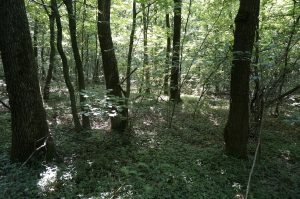
The forest of Vytan near Bukachivtsi, where more than 200 Jews hid for up to two and a half years. Photo © 2018 RJH.
Unnamed 08 (Vytan, near Bukachivtsi)
reference: [20, p.128, 149-150]
A Polish forester working in the woods surrounding the small village of Vytan near Bukachivtsi aided Jews hiding there during the German occupation. Several times he warned them of German military and Ukrainian militia operations in and around the forest, which primarily targeted Polish partisans active in the forest but which endangered Jews as well; the Jews avoided leaving their bunkers at those times, including one armed siege with artillery which lasted for four days. The forester also told the Jews and partisans about a Ukrainian living near the edge of the forest who served as an informant for the Nazis, disclosing hiding places for rewards; some Jews joined with the partisans to attack and kill the man. According to Lina-Liba Kasten: “The Polish forester helped the Jews in the forest as much as he could. After the war, we, the hidden “forest people”, did not forget his help during the cruel war time. To my knowledge, some survivors made a request to the Polish government to honor him for his help and for the risk he had taken. I seem to remember that the forester was given a small farm in Poland.”
Sources:
[1] Yad Vashem; Database of Righteous Among the Nations; online and continuously updated. [2] Remembering Rohatyn and Its Environs; Donia Gold Shwarzstein, editor; Meyer Shwarzstein, publisher; 2019. (Remembering Rohatyn includes a revised and corrected English translation of the Rohatyn Yizkor Book, with significant supplemental material and an index of names and places.) [3] I Survived the German Holocaust Against All Odds; Jack Glotzer; bilingual Ukr./Eng. edition; Ukrainian Center for Holocaust Studies; 2022. [4] A Journey Through Grief – The Autobiography of a Holocaust Survivor; Rosette Faust Halpern; lulu.com; 2013. [5] “Autobiographical Notes”; Alexander Kimel; in: Eric J. Sterling, ed., Life in the Ghettos During the Holocaust; Syracuse University Press; New York, 2005. Also: Selected pages “The Rescue“, “In Hiding“, and “Liberation” from Kimel’s self-managed website kimel.net, now offline but partially archived on the Internet Archive Wayback Machine. [6] Sheva’s Promise – Chronicle of Escape from a Nazi Ghetto; Sylvia Lederman; Syracuse University Press; New York, 2013. [7] Oral interview #5039 with Klara Schnytzer by Ursula Flicker OAM, 14 January 1980, for the B’nai Brith 1980 Holocaust Exhibition, copyright Melbourne Holocaust Museum (MHM, formerly the Jewish Holocaust Centre). [8] Among Men and Beasts; Paul Trepman; translated from the Yiddish by Shoshana Perla and Gertrude Hirschler; A. S. Barnes and Co., Inc.; Cranbury, New Jersey, 1978. [9] Моя Гірка Правда (My Bitter Truth); Boris Arsen; Bohdan Mykhailiuk, ed.; Nadvirnianska Printing House; Nadvirna, 2005. [10] Yahad – In Unum Interviews with Rohatyn Holocaust Witnesses (Ukrainian); Yahad – In Unum; 2016. [11] Visual History Archive; USC Shoah Foundation; online and continuously updated. [12] Third decree concerning limitations of residency in the General Government; Verordnungsblatt für das Generalgouvernement; Warsaw, 15Oct1941; in Polacy-Żydzi 1939~1945, Selection of Documents; Andrzej Krzysztof Kunert, ed.; Muzeum Historii Polski; Warszawa 2006. [13] A Journey Through Illusions; Kurt I. Lewin; Fithian Press; Santa Barbara, 1994. [14] Personal communications between Cipora Blitz, Chaya Rosen, and Rohatyn Jewish Heritage, 2018-2019. [15] Personal communications between Ihor Rykhlevych and Rohatyn Jewish Heritage, 2019. [16] Personal communications between Janusz St. Andrasz and Rohatyn Jewish Heritage, 2021. [17] Personal communications between Anna Brzyska, Witold Wrzosiński, and Rohatyn Jewish Heritage, 2021. [18] [19] [20] USC Shoah Foundation interviews with survivors Avi Blitz (VHA #12915, 1996), Joseph Blitz (VHA #15985, 1996), Cipora Blitz (VHA #15986, 1996). [21] Versteckt unter der Erde – Die Überlebensgeschichte der Familie Kasten (Hidden Under the Earth – The survival story of the Kasten family); Dina Dor-Kasten; translated from Hebrew to German by Eva Tyrell and edited by Ruth Snopkowski for the Gesellschaft zur Förderung jüdischer Kultur und Tradition e.V.; Metropol Verlag; Berlin, 2016.General Sources:
- The Righteous: The Unsung Heroes of the Holocaust; Martin Gilbert; Henry Holt and Company; New York, 2004.
- Righteous Among Nations: How Poles Helped the Jews, 1939-1945; Wladyslaw Bartoszewski and Zofia Lewin, eds.; Earlscourt Publications; London, 1969.
- The Jewish Foundation for the Righteous (charity organization); website, updated periodically.

